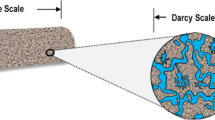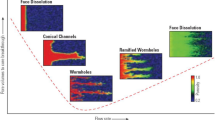A 3D continuum simulation model of carbonate matrix acidizing is introduced to study the effect of different dimensions on the dynamic wormhole propagation process. The results obtained show that the wormhole propagation process passes through four stages – competition, dominant wormhole, wormhole breakthrough, and wormhole extension (injection pressure ratio dropping to 1%). In previous studies, the wormhole breakthrough stage was reported to occur when the injection pressure ratio had fallen to 3% instead of 1%. Wormhole simulation using 3D and 2D models at different injection rates indicate that the injection rate and breakthrough volume are optimal in both dimensions, the values of both parameters being higher in 2D than in 3D simulation. This trend is expected, since previous studies also show that the optimal rate and breakthrough volume are lower in 1D than in 2D simulation. CT scanning of limestone cores after acidizing show that the corresponding optimal breakthrough volume for a dominant wormhole is less than 3.1 pour volume (PV). The obtained data closely match the 3D simulation data (2.7 PV) and differ greatly from the 2D simulation data (10 PV). Based on the study, a higher-dimension model should be selected for simulating wormhole propagation and optimizing matrix acidizing as this can help improve the accuracy and efficiency of carbonate reservoir acidizing simulation.





Similar content being viewed by others
Change history
24 February 2018
The second author’s name should read LiQiang Zhao.
References
Jia Xiaole, Dengfa He, Xiaguang Tong, et al., Distribution of global giant oil and gas fields, China Petroleum Exploration, 16, No. 3, 1–7 (2011).
Guoping Bai, Distribution patterns of giant carbonate reservoirs in the world, J. Paleogeography, 8, No. 2, 241–250 (2006).
T. Huang, D. Zhu, and A. D. Hill, Prediction of wormhole population density in carbonate matrix acidizing, in: European Formation Damage Conference (1999), pp. 161–167.
A. Budek and P. Szymczak, Network models of dissolution of porous media, Phys. Rev. E. Statistical Nonlinear and Soft Matter Physics, 86, No. 2, 3419–3432 (2012).
T. Pichler, T. P. Frick, M. J. Economides, et al., Stochastic modeling of wormhole growth in carbonate acidizing with biased randomness, in: European Petroleum Conference. Society of Petroleum Engineers (1992).
M. K. R. Panga, M. Ziauddin, and V. Balakotaiah, Two-scale continuum model for simulation of wormholes in carbonate acidization, AlChE J., 51, No. 12, 3231–3248 (2005).
Q. J. Kang and P. C. Lichtner, Pore-scale model for multi-component reactive transport in porous media, Abstracts of Papers of Amer. Chem. Soc., 230, U1719–U1719 (2005).
N. Kalia and V. Balakotaiah, Effect of medium heterogeneities on reactive dissolution of carbonates, Chem. Engr. Sci., 64, No. 2, 376–390 (2009).
M. Liu, S. Zhang, and J. Mou, Effect of normally distributed porosities on dissolution pattern in carbonate acidizing, J. Petrol. Science and Engin., 94, 27–38 (2012).
O. Izgee, D. Zhu, and A. D. Hill, Numerical and experimental investigation of acid wormholing during acidizing of vuggy carbonate rock, J. Petrol. Science and Engin., 74, No. 1, 51–66 (2010).
C. E. Cohen, D. Ding, M. Quintard, et al., From pore scale to wellbore scale: Impact of geometry on wormhole growth in carbonate acidizing, Chem. Engr. Sci., 63, No. 12, 3088–3099 (2008).
M. Liu, S. Zhang, and J. Mou, Fracture nature of acid-etched wormholes and the influence of acid type on wormholes, Petrol. Explor. and Develop., 39, No. 5, 630–635 (2012).
M. Liu, S. Zhang, J. Mou, et al., Diverting mechanism of viscoelastic surfactant-based self-diverting acid and its simulation, J. Petrol. Science and Engin., 105, 91–99 (2013).
R. R. Ratnaker, N. Kalia, and V. Balakotaiah, Modeling, analysis and simulation of wormhole formation in carbonate rocks with in situ cross-linked acid, Chem. Engr. Sci., 90, 179–199 (2013).
G. T. Bulgakova, R.Y. Kharisov, A. V. Pestrikov, et al., Experimental study of a viscoelstic surfactant-based in situ self-diverting acid system: results and interpretation, Energy and Fuels, 28, No. 3, 1674–1685 (2013).
P. Liu, H. Xue, L. Q. Zhou, et al., Analysis and simulation of rheological behavior and diverting mechanism of in situ self-diverting acid, J. Petrol. Science and Engin., 132, 39–52 (2015).
P. Maheshwari, R. R. Ratnakar, N. Kalia, et al., 3-D simulation and analysis of reactive dissolution and wormhole formation in carbonate rocks, Chem. Engr. Sci., 90, 258–274 (2013).
Y. Hao, M. Smith, Y. Shlokhova, et al., CO2-dissolution of low permeability carbonates. Part II. Numerical modeling of experiments., Adv Water Resources, 62, 388–408 (2013).
P. I. Liu, H. Xhu, L. Q. Zhao, et al., Simulation of 3D multi-scale wormhole propagation in carbonates considering correlation spatial distribution of petrophysical properties, J. Natural Gas Science and Engineering, 32, 81–94 (2016).
M. Smith, Y. Hao, and S. A. Carroll, Development and calibration of a reactive transport model for carbonate reservoir porosity and permeability changes based on CO2 core-flood experiments, Inter. J. Greenhouse Gas Control, 57, 73–88 (2017).
N. Kalia and V. Balakotaiah, Modeling and analysis of wormhole formation in reactive dissolution of carbonate rocks, Chem. Engr. Sci., 62, No. 4, 919–928 (2007).
Panga, Multiscale Transport and Reactions: Two Case Studies, Univ. Houston (2003).
C. N. Fredd, H. S. Fogler, et al., Optimum conditions for wormhole formation in carbonate porous media: Influence of transport and reaction, SPE J., 4, No. 3, 196–205 (1999).
The work reported on in the article was supported by a grant from the National Natural Science Foundation of China, No. 5147182, and the 13th Five-Year National Project of China, No. 2017ZX005030005.
Author information
Authors and Affiliations
Additional information
Translated from Khimiya i Tekhnologiya Topliv i Masel, No. 5, pp. 60-66, September-October, 2017.
A correction to this article is available online at https://doi.org/10.1007/s10553-018-0889-8.
Rights and permissions
About this article
Cite this article
Xue, H., Zhang, L., Liu, P. et al. Simulation and Analysis of Wormhole Propagation in Carbonates Through the Use of Models with Different Dimensions. Chem Technol Fuels Oils 53, 727–738 (2017). https://doi.org/10.1007/s10553-017-0855-x
Published:
Issue Date:
DOI: https://doi.org/10.1007/s10553-017-0855-x




